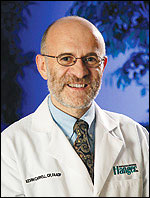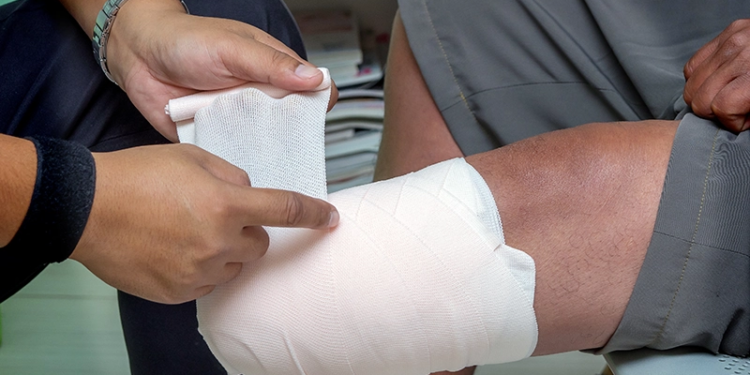
Kevin Carroll, MS, CP, FAAOP, vice president of prosthetics, Hanger Prosthetics & Orthotics, Bethesda, Maryland, is one of O&P’s most well-known practitioners. As a researcher, educator, international speaker, and clinician, the high-energy native of Ireland is known for using his compassion, humor, and intellect to solve some of O&P’s most difficult puzzles. He travels worldwide for Hanger, and his patients have included some of the oldest successful first-time prosthesis users, exceptionally athletic multiple amputees, and even a tailless dolphin that resides in a Florida aquarium. Carroll has been featured on 20/20, NBC Nightly News, Dateline, ABC’s Good Morning America, CBS Early Show, and the Discovery Channel. Recently, he was featured in Time magazine’s “Innovators: Building a Better Athlete.” Carroll went to Beijing to provide non-technical support to Paralympic athletes who receive care from Hanger. In an interview two weeks after his return from the Games, Carroll told The O&P EDGE how Paralympic sports can help every O&P patient.
The O&P EDGE:
You just returned from the Paralympic Games. What were some of the most dramatic moments that you witnessed there?
Carroll:
I actually got to see some of those famous wheelchair crashes-wild. You can imagine the speed when they’re coming around the bend, and the next thing you know, one of them twists and the wheelchairs crash together like the Indy 500. You know, it’s exciting when it happens, especially when you see everybody getting up and they’re safe and sound, and there’s big applause from the whole audience.
Another big event was watching Jeremy Campbell throw the discus. I was very excited for Jeremy; it was phenomenal to see him in action. It was his last throw that got him the gold medal. You know, if you turn for a second, you’re going to miss that. I was fortunate enough to be out on the track in that atmosphere. It was just phenomenal. Some 91,000 people were in the stadium. You can imagine the excitement, especially for the athletes. They were coming from the qualifying events that they had competed in at home to get to that level, and how many people had shown up at those home events? At some, there’d be 300, 400, 500, even 600 people. Maybe some events they go out there and there were 100 people. For people in some countries, there’s nobody. Now they’re on the world stage, the second largest sporting event in the world, and the stadium was packed with some 91,000 people-packed solid.
The O&P EDGE:
One of the things you’re best at is inspiring people to move forward with their lives after having an amputation. Now that you’re back to work, what will you think of when you want to draw on your experiences at the Paralympics to inspire people?
Carroll:
Well, I’m on a high since we came back-and as you know, I’m a very energized person to begin with-but this energized me more than ever to encourage people with physical challenges to go out and be active in sports.
Yesterday, I spent several hours with this young kid and her mom and her team of clinicians, and we talked about how we can help her get involved with sports, and we talked about the Challenged Athletes Foundation [CAF] and such groups out there that can help out. Her eyes lit up, and she got a big smile on her face, and her mom said, “Yeah, we want to get involved.” The Challenged Athletes Foundation has been around for quite some time, so how many other young kids are out there across the country who don’t know about it or about Disabled Sports USA [DS/USA]? There are huge opportunities for us as clinicians to educate our consumers and let them know that these opportunities are there. There are organizations to help and support, like the U.S. Paralympic Committee, but it’s up to us to get that word out. It’s up to us to encourage these young people to get out, and to give them as much support as we possibly can.
The O&P EDGE:
I imagine that some people hear about the Paralympics and think, “Well, those people are ‘real’ athletes-elites-and that doesn’t have anything to do with ordinary people with disabilities-people like me.” So why are sports important for ordinary people who have disabilities? Did you see anything in Beijing that demonstrated that?
Carroll:
Well, at the opening ceremony, various athletes were coming out, representing their countries, and you know, they’re not all young, 20-year-old, super-muscled men and women. Some of them are in their wheelchairs, some of them are out there with their crutches, crutching it along, some of them are a little overweight, but they’re there. And you can imagine that if they weren’t athletic, the condition that some of them could be in. More would be in wheelchairs and some of them could be very much overweight. But somehow, they got motivated to get out and work hard and get healthy.
Of those same athletes, one particular gentleman from Mexico, I saw him coming out on short prosthetic legs, both of his legs gone above the knees, and I said to myself, “He’s walking on very short legs, hats off to him, good for him.” As the week progressed, we followed him, thinking, “We’ve got to see this guy; what’s he going to do?” And he was out there, throwing the shot put, doing incredibly well with it. His sport was motivating him to get up and be healthy.
We work with our patients across the country, and oftentimes they say, “Before the injury, I was kind of athletic. Can I get back to being athletic again?” Or they say, “I used to be kind of athletic before, but now that this has happened, maybe I need to think of really doing some exercise.” Then they get a sport that they like, and you’re soon seeing, wow, this guy is really good at that particular sport, and he’s out there, participating. It’s for us, again, as clinicians, to point out all of the opportunities that are there. There is a wide range of sports. Some of these guys who do archery, they’ve got no arms, but they’re holding their bow and pulling the string back with their mouth, and getting the arrow go into the dead center of the bulls-eye.
Not everybody is going to be a superstar athlete. But there are things that people can do, and for those who don’t want to compete, healthy living is important, even if it’s just to jump into a pool and swim up and down a couple of times. You don’t have to be a superstar athlete to do that.
The O&P EDGE:
What about people who are very fragile, or very elderly-people who can’t even do that much? Can sports contribute anything to them?
Carroll:
These athletes that I saw two weeks ago, they’re raising the bar. They’re inspiration, and they provide us with the encouragement to come up with better prosthetic and orthotic systems-better wheelchairs, better systems that will help them achieve their goals and their dreams and aspirations-and when they do that, they’re helping that little old lady who’s living at home, using their prosthetic system. Maybe she has a skin issue that has been problematic and we might use a solution that has been developed for these Paralympic athletes to compete at high levels without skin issues. So, these guys are making a huge difference in the encouragement of our people at home. Even if they’re just seeing those athletes on television, people are thinking, “Wow, look at what that guy’s doing. Well, if he can do that, or she can do that, I surely can take a few steps across the floor and have some fun with my grandchildren.” They’re making a huge difference out there.
Editor’s note: For more interviews with Paralympians and their prosthetists, see the related articles below.




